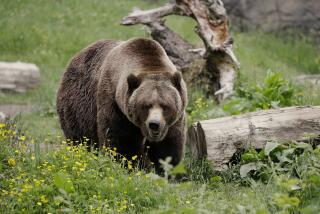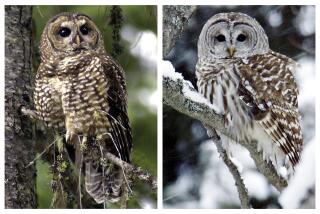Alaska Studies Its Programs to Control Predator Populations
- Share via
JUNEAU, Alaska — Large-scale wolf kills might temporarily leave more moose and caribou for human hunters in Alaska, but long-term effects on big game are unknown, according to a recent report.
The study by the National Research Council, the working arm of the National Academy of Sciences, recommended a cautious review of the economic, social and biological need to kill wolves and bears before Alaska resumes predator management.
The effects of previous predator-control programs in Alaska and Canada were not adequately evaluated, so researchers were unable to judge whether game herds would continue to flourish after large numbers of wolves or bears were killed, according to the report, released Oct. 28.
“We stress that complete predictability never will be possible, and the public must understand that unexpected outcomes will always be part of wildlife management,” said Gordon Orians, an ecologist at the University of Washington in Seattle who headed the study.
The yearlong study was requested by Gov. Tony Knowles, who called off a wolf-kill program when he took office in 1994 after videotape aired nationwide showing wolves suffering in snares in interior Alaska.
Wildlife groups applauded the decision, saying such methods were cruel and unnecessary. Hunters say the state bowed to public pressure from outside Alaska and that predator control is needed to keep wolves from decimating game populations.
Alaska paid the academy about $300,000 for the study to help the state decide whether it should resume killing predators or try less severe methods such as sterilizing the animals or moving them away from game herds targeted by hunters. The report does not recommend whether Alaska should reinstate predator-control programs.
State wildlife managers plan to begin this month a sterilization program for wolves that prey on the Fortymile caribou herd, which numbered as high as 500,000 in the 1920s but has dwindled to about 25,000.
“They’re still on target,” said Diane Reagan, a spokeswoman for the Alaska Department of Fish and Game. “It’s a nonlethal wolf control method that calls for vasectomies on males and tubal ligations on females. Just the alpha pairs. They’ll be relocating the sub-adults to other areas rather than killing them.”
The 207-page report was based on discussions with government biologists, reviews of previous research on predator management and comments from people living in remote Alaska villages that depend on big game for food.
Researchers also examined 11 predator-control programs in Alaska and Canada. The results on moose and caribou herds were inconclusive in most of those programs, the report said.
But a few of the programs indicated that killing off 40 percent or more of wolves in a given area for at least four years can result in short-term increases in moose and caribou numbers, Orians said. However, whether that translates into long-range game increases could not be determined, he added.
More to Read
Sign up for Essential California
The most important California stories and recommendations in your inbox every morning.
You may occasionally receive promotional content from the Los Angeles Times.









